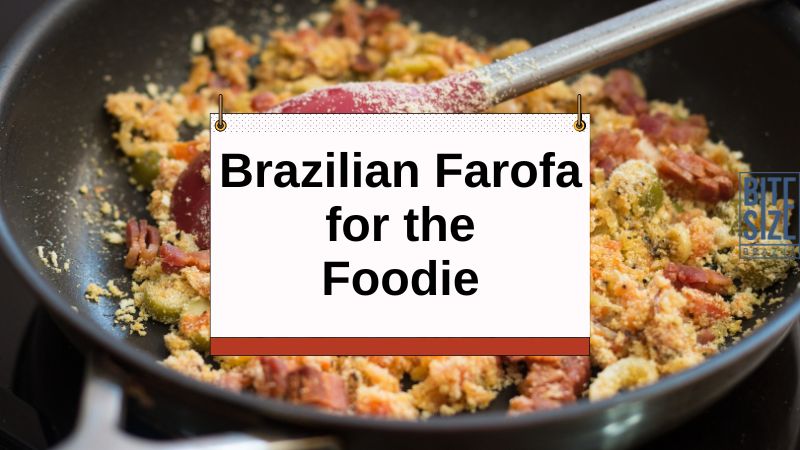Well, I’m Brazilian, so my experience with the Brazilian farofa spans a lifetime.
But the only personal anecdote I’d like to share with you is also an emotional memory I’m fond of.
When I was a teenager, my parents were through a down phase. Money was harsh, my parents were about to divorce, and life at home was generally challenging. So, on one of the New Year’s Evenings we spent at home at that time, we didn’t have money to buy enough food.
My mother went to the kitchen and, in her matter-of-fact way, whipped up a quick dish for us:
Beans and farofa.
We used to make little bean balls with farofa as glue. We used to call it “capitão” (captain). And it tastes so good, but on that night, it tasted special.
To this day, I still love farofa, and that love is what I want to share with you.
Now, enough emotional stories. Let’s get to the facts!
If you haven't heard of Brazilian farofa yet, you’re missing out.
This versatile and flavorful side dish has been a staple of Brazilian cuisine for centuries.
Whether you're a seasoned traveler or a foodie looking for new culinary experiences, farofa is a must-try dish that will transport your taste buds straight to Brazil.
In this blog post, we'll explore everything you need to know about Brazilian farofa, from its origin to its cultural significance and beyond.
Brazilian Farofa: what is it, and where does it come from?
First things first: what is farofa?
Essentially, it's a toasted or fried cassava flour mixture that can be seasoned with various ingredients.
In Brazil, farofa is often served as a side dish for feijoada, (and if you don’t know what feijoada means, what kind of Brazilian expert are you?). However, farofa can also be enjoyed on its own or paired with other dishes.
The origins of farofa are somewhat unclear, but it's believed to have been introduced to Brazil during the colonial period.
Cassava flour, the main ingredient in farofa, was a staple of indigenous Brazilian cuisine long before European contact.
However, the addition of seasonings and cooking techniques used in modern-day farofa likely came from Portuguese colonizers.
Farofa's common ingredients… are really, really common!
You can go simple or fancy with ingredients to prepare your Brazilian farofa.
One of the great things about farofa is that it can be made with a wide variety of ingredients to suit your taste.
WARNING: Many farofa recipes call for salt, which can contribute to high levels of sodium intake. Excessive sodium intake has been linked to high blood pressure and other health problems. To mitigate this issue, use less salt or opt for low-sodium ingredients when making farofa. And skip ready-made farofa found in supermarkets altogether.
From the basics, you can put in anything, from bacon and onions to peppers and herbs.
Some popular variations of farofa include:
- Farofa de bacon: Made with crispy bacon, onions, and garlic.
- Farofa de ovo: Made with scrambled eggs, onions, and parsley.
- Farofa de milho: in this one, milho (corn) is the main ingredient of the flour, not cassava. It also has onions and scallions.
Whipping Up Your Own Brazilian Farofa
Ready to try making your own farofa? Here's a simple recipe to get you started:
Ingredients:
- 1 cup cassava flour
- 3 tablespoons butter or oil
- Salt to taste
- Optional: bacon, onions, garlic, herbs, or other seasonings of your choice
Instructions:
- Melt butter or heat oil in a skillet over medium heat.
- Now it’s time to add bacon or onions and sauté until crispy or caramelized.
- Add cassava flour and stir continuously until flour is lightly toasted and fragrant, about 2 minutes.
- Sprinkle with salt and any additional seasonings to taste.
- Serve warm alongside your favorite Brazilian dish.
Exploring Fun Facts and Variations
Farofa also has cultural significance in Brazil beyond just its culinary uses.
It's often used in religious ceremonies and festivals like Candomblé and Umbanda.
In these contexts, farofa can be used as an offering to gods and spirits or sprinkled around the perimeter of sacred spaces.
And living in Salvador, Bahia, I’ve seen many dishes of delicious-looking farofa in some places. In the past, I’d usually be baffled by the sight, but now I find it so interesting.
National and International Chefs pitch in.
Farofa may have humble origins, but it's now a beloved and iconic part of Brazilian cuisine. Whether you're enjoying a street food snack (our famous espetinho), a home-cooked meal, or a fancy restaurant dish, you’ll likely encounter farofa.
The versatility of farofa means that it can also play a role in fusion or modern cuisine. Brazilian — and international — chefs experiment with new ways to use farofa [in Portuguese], such as incorporating it into desserts or using it as a crust for savory dishes.
Chef Emmanuel Bassoleil, originally from France, stated that he loves to “use and abuse” farofa, adding that it always enchanted him. He also mentioned that it can be served with barbecue, fish, bacon, or egg (it’s most common uses).
The Japanese chef Kaori Muranaka expressed her enthusiasm for mixing different flavors and trying new recipes. She said she likes to add farofa and vinaigrette to her dishes because they taste great when mixed together (and she’s right).
Nadia Pizzo, executive chef at Ráscal, said she loves feijoada as one of her favorite meals in Brazil after having it for the first time 30 years ago.
If you're a foodie, you've got to try Brazilian farofa — don’t take it from me; take it from those chefs 🙂 This versatile ingredient is a favorite among culinary pros and loved by many.
Final thoughts
Personally, I absolutely love Brazilian farofa. It's not just a tasty and versatile dish; it also has a rich history and cultural significance that makes it all the more special.
If you have yet to try it, I highly recommend giving it a go and incorporating it into your cooking repertoire. Trust me, your taste buds will thank you!
And if you ever find yourself in Brazil, be sure to order some farofa alongside your feijoada - it's an experience you will want to have in your memories.

